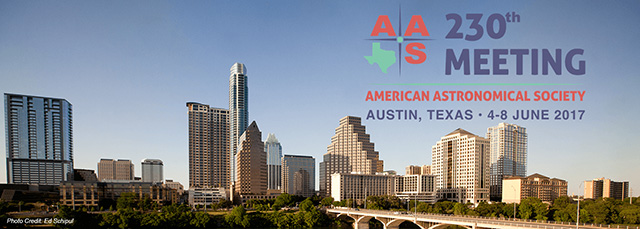AAS Does the Texas Two Step

Richard Fienberg Running Hare Observatory
The dust has barely settled from the 229th AAS meeting in Grapevine, Texas, near Dallas-Fort Worth airport, yet here we are gearing up to return to the Lone Star State for the 230th meeting. Our summer 2017 gathering takes place 4-8 June at the JW Marriott Austin, 110 E 2nd St., Austin, TX 78701. AAS members very much enjoyed our January meetings in the Texas state capital in 2008 and 2012, but our winter conferences have outgrown the city, so this time we’re heading there for our smaller summer meeting. Registration is now open; the regular deadline is 14 April. Abstract submission is open too, with a regular deadline of 2 March. Rooms at the JW Marriott Austin are available at special AAS group rates through 14 May.
To quote from the hotel’s website, “The city of Austin has a unique way of doing just about everything. All the time. From the nearly 200 live music venues — making it the ‘Live Music Capital of the World’ — to the trendy ‘street eats’ springing up all over town. If you’re looking for an authentic meeting experience, Austin is it. And if you’re looking for an upscale, unique meeting venue, look no further than the JW Marriott Austin."
Our Laboratory Astrophysics Division (LAD) will hold its annual meeting in conjunction with the 230th AAS meeting. It will feature numerous oral and poster sessions on the theme “Bridging Laboratory and Astrophysics,” with topics ranging from ices in the solar system to plasmas in active galactic nuclei.
A unique feature of AAS summer meetings is the degree to which members help shape the program by organizing one-off Special Sessions and multisession Meeting-in-a-Meeting (MiM) sessions. A special session entitled “Topics in Astrostatistics” will explore the intersection of observational astronomy, statistics, and data science through invited lectures by topical experts and contributed posters by other practitioners. A six-session MiM will introduce the projects to be tackled by teams with guaranteed observing time on the James Webb Space Telescope (JWST), whose long-awaited debut is now less than two years away. This MiM will also be accompanied by poster sessions. And Rebekah Dawson (Pennsylvania State University), recipient of the 2017 Annie Jump Cannon Award for her work on exoplanets, is organizing an MiM, “Inner Solar Systems,” on so-called hot Jupiters and other planets orbiting inexplicably close to their host stars.
Dawson is one of more than a dozen distinguished scientists who will present invited or prize lectures in Austin. Among the others are Katherine Freese (University of Michigan and Stockholm University), who will kick off the meeting with the Kavli Foundation Lecture on where we stand in our quest to understand and identify dark matter. Manfred Schüssler (Max Planck Institute for Solar System Research) will have his day in the sun as recipient of the Solar Physics Division’s George Ellery Hale Prize for his work on the solar dynamo, and Hernán Quintana (Pontificia Universidad Católica de Chile) will give the AAS Education Prize lecture on developing and bringing astronomy education and degree programs into Chilean universities.
Delores Knipp (University of Colorado, Boulder) will scare the heck out of us by talking about space weather and the coupling between the solar wind and Earth’s magnetosphere. David Koo (University of California, Santa Cruz) will relate what we’ve learned about galaxy evolution by studying the most distant galaxies. Caitlin Casey (University of Texas, Austin) will focus instead on the strange beasts known as submillimeter galaxies, which aren’t extremely tiny galaxies, as their name implies, but star systems that emit strongly at short radio wavelengths. Toward the other end of the spectrum, X-rays from the center of our own galaxy will be the subject of a plenary talk by Daniel Wang (University of Massachusetts, Amherst).
High flyers will appreciate hearing from Erick Young (Universities Space Research Association) about key science highlights from the Stratospheric Observatory for Infrared Astronomy. As we celebrate the 30th anniversary of Supernova 1987A, Doug Leonard (San Diego State University) will discuss the identification of supernova precursors. And if you grew up in a solar system with nine planets, you’ll not want to miss hearing the latest on the search for “Planet Nine” from Konstantin Batygin (Caltech).
Bonnie Buratti (Jet Propulsion Laboratory) will give a LAD plenary talk on results from the European Space Agency’s Rosetta mission to Comet 67P/Churyumov-Gerasimenko. The recipients of LAD’s 2017 Laboratory Astrophysics Prize, Early Career Award, and Dissertation Prize will each give lectures in Austin too: James Lawler (University of Wisconsin, Madison), Carolyn Kuranz (University of Michigan), Kyle Walker (Université du Havre, France), respectively.
Professional development is a big part of every AAS meeting, and Austin will be no exception. Among the workshop offerings are “Impacting Broader Audiences with Your Research,” “JWST Proposal Planning,” and “Get the Job! Next Step Career Planning Workshop and Panel.” In addition, Alaina Levine of Quantum Success Solutions will offer one-on-one consultations to provide confidential, customized career advice for students, mid-career scientists, and anyone in-between. These consultations, and some of the workshops, require pre-registration and payment of a small fee; see the AAS 230 Workshops page for more information.
One reason Austin has always been a popular venue for AAS meetings is that there’s so much to see and do there. Abundant live music, restaurants to suit every taste, and the city’s “Keep Austin Weird” culture are just the beginning. Austin is also home to a wonderful ballet, world-class museums, one-of-a-kind shopping, and beautiful outdoor spaces. Come for the science, but enjoy the city too!




